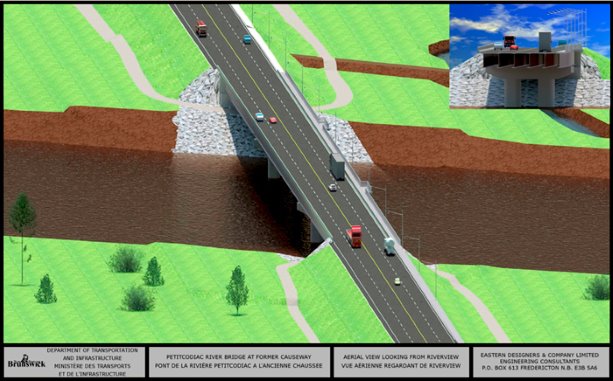Replacing a 49-year-old causeway with a 240-metre steel girder bridge across the Petitcodiac River in New Brunswick is meant to improve traffic flow and help restore one of the most important ecosystems in Atlantic Canada.
The first phase of construction — the bridge’s substructure — has commenced. Caldwell & Ross Limited is the general contractor.
When the four-phase project is completed in 2020, the four-lane crossing with a three-metre sidewalk will carry an average of 26,000 vehicles a day between Riverview and Moncton, making it one of the busiest crossings in New Brunswick. It will feature two lookouts at bridge pier caps on either side of the river, offering visitors views of the returning tidal bore, which is one of the highest in the world.
"This is one of the most complex projects for me because there is so much going on at any given time," says Mike Pauley, a project manager with New Brunswick’s department of transportation and infrastructure, who has been with the province for 22 years.
The $61.5-million project is funded by the province and federal government.
The crossing includes a realignment of the river channel to its location before the causeway was constructed in 1968.
"That’s not done very often anymore," says Pauley, adding that complicating the project is that the tidal estuary brings in "copious amounts of silt."
Most of the material to be excavated for the river channel is infill from the 1960s when the old riverbed was buried to make way for the causeway, Pauley says.
The bridge is being built "in the dry" to eliminate the need for river protection. It will be partly constructed on the earthen causeway.
Tremie concrete (poured underwater) will be placed at footings in two locations because even though the project is being constructed on dry land, Pauley says water seepage is inevitable.
The channel underneath the bridge will be 170 metres long at high tide, allowing for Atlantic salmon migration.
Pauley says the bridge design takes into account climate change.
"We’re working with some other engineers and scientists to determine what that elevation will be for the underside of the girders because of tides creeping up," he explains.
The new bridge is the third phase of "a big environmental project" that aims to see the return of spawning salmon and other marine life.
In 2010, gates were installed in the earthen causeway to allow fish migration. The result was that the artificial head pond, which formed when the causeway was built, was drained, allowing the tidal flow to return to normal.
But prior to opening the gates, 23 kilometres of dykes and aboiteau earth dams were installed upstream to protect farmland and riprap (quarried rock) protection was placed along the slopes to protect a hotel and hiking trails, he says.
"We had a multitude of things to do before we could open up the (causeway) gates," he adds.
But the causeway gates didn’t meet environmental goals for returning the salmon to spawn in the river. Studies indicated the construction of the bridge and a realignment of the river channel was the best solution.
The bridge’s substructure is slated for completion in July 2018. Three tenders will follow, including one to be issued this fall for the bridge’s superstructure.
The deck, roadwork and gate decommissioning will follow and the last tender will be earthworks and the channel’s excavation, Pauley says, noting the bridge is scheduled for substantial completion in 2020.
The Petitcodiac Causeway Project is owned by the province. Amec Foster Wheeler is the environmental consultant and Eastern Designers and Company Ltd. is the bridge design consultant.











Recent Comments
comments for this post are closed